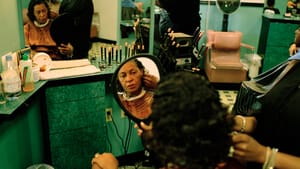Stay in the Loop
BSR publishes on a weekly schedule, with an email newsletter every Wednesday and Thursday morning. There’s no paywall, and subscribing is always free.
More than meets the eye
AAMP's 'Went Looking for Beauty: Refashioning Self,' Photographs by Deborah Willis

You could glance at the photograph of a woman having her hair done and move on, thinking you’ve seen all there is to see. Instead, take a breath. “Carrie in the Salon” (2010) rewards patient inspection, as do so many of Deborah Willis’s images in Went Looking for Beauty: Refashioning Self, at the African American Museum in Philadelphia (AAMP).
Depth is inherent in the work of the Philadelphia-born artist, author, and scholar. In addition to her work as a photographer, she is a historian and curator of African American photography and culture. Willis, chair of photography and imaging at New York University’s Tisch School of the Arts, previously served as curator at New York Public Library’s Schlomberg Center for Research in Black Culture and at the Smithsonian Center for African American History and Culture.
True to these studious roots, there is always more to see and learn in what she shoots.
Meaning seen, unseen
“Carrie at the Salon” places the viewer at the stylist’s shoulder, surrounded by a constellation of reflection. There’s the teardrop-shaped glass the customer holds as she inspects her hair. A wall mirror reflects the stylist’s satisfied smile and provides a prismatic view.
Willis captures the whole salon in reflected shards. Six more people are visible, but it takes time to find them. The composition is impressively arranged, enabling the eye to bank and carom like a billiard ball. Rectangles and circles subtly repeat through the scene in drawer fronts, light fixtures, and dryer hoods. Then there’s what isn’t visible.
Salons’ significance
“Carrie” takes on added significance if one knows that the subject is artist and writer Carrie Mae Weems and that the salon is in Eatonville, Florida, childhood home of Zora Neale Hurston, an African-American writer of the 1920s. Beyond that lies the meaning of beauty shops to African-American women.
They are a theme in Willis’s photography — and were part of her childhood. In “Mrs. McGee and my mom, Ruth Willis (Apex alums) in her beauty shop in North Philadelphia” (undated), she shows us the neighborhood shop she knows best, where signs remind customers, “No children in the salon unless a service is being rendered” and “Please limit phone calls to 3 minutes.” A posted service menu lists weaves, wraps, press and curls, and wet sets.
Ruth Willis and her client were graduates of Apex College of Beauty Culture, once at 16th and Lombard Streets, which provided training at a time when, as historian J.M. Duffin wrote in a 2017 report, “Beauty parlors offered women a degree of autonomy and economic independence. For African-American women, a career in beauty culture provided a much better opportunity than the work typically available to them as servants, cleaners, or washerwomen.”

For Willis, the women who work in and visit salons are transformed. Customers become more beautiful but they also relax and socialize, while the stylists caring for them receive recognition for their skill and build financial independence. These were rare achievements for women of any ethnicity for much of the 20th century.
Shedding light on black photographers
Willis’s father was a photographer, and as artist and author, his daughter is raising awareness of African Americans in photography. In 1984 she edited Black Photographers 1840-1940: An Illustrated Bibliography, the first such comprehensive listing. “People who aren’t familiar with the history, the fact that black photographers were active in the 19th century, are really amazed and surprised at the images,” she told the New York Times in 1989.
Another group of images at AAMP depicts exquisite garments, and while they can be appreciated for beauty alone, you have to wonder if there’s more to know. Most of the dresses and shoes float in a deep black void without explanation, leaving space for viewers to interject.
Take “Cathy”: impossibly long, narrow pumps, made to appear longer and narrower by black-and-white stripes running from heel to toe. Mustn’t the owner look like Olive Oyl? Or “Wayne,” represented by black dress shoes, brown oxfords, and casual slip-ons, arranged on deeply woven, knobby carpeting. Though creased with wear, they’re neat and polished, but these shoes don’t go with that luxurious rug.
Reframing painful images
In Italy, Willis turned her lens on the blackamoor, an offensive icon still seen in art and decorative items. Dark-skinned and subservient, a small carved figure stands in wait in “Blackamoor in Florence" (2014). His arms are extended, as if to accept a tray or other burden. Willis framed the shot to include a white marble David towering over him.
In “Blackamoor Table Base in Florence” (2014), he balances a tabletop on his legs, forearms and chest pressed against the floor, spine curved into a backward “c.” Though not flesh and bone, his position is painful to imagine. As jewelry in “Blackamoor Earrings Shop Window Florence” (2014) the figures wear bejeweled hats and collars and hang from a display stand above a polished black surface. In the shiny surface, only the bright gems are visible; the dark faces disappear.
“See?” Willis seems to be saying. “All that’s needed to understand is a little reflection.”
What, When, Where
Went Looking for Beauty: Refashioning Self, Photographs by Deborah Willis. Through April 29, 2018, at the African American Museum in Philadelphia, 701 Arch Street, Philadelphia. (215) 574-0380 or aampmuseum.org.
Sign up for our newsletter
All of the week's new articles, all in one place. Sign up for the free weekly BSR newsletters, and don't miss a conversation.
